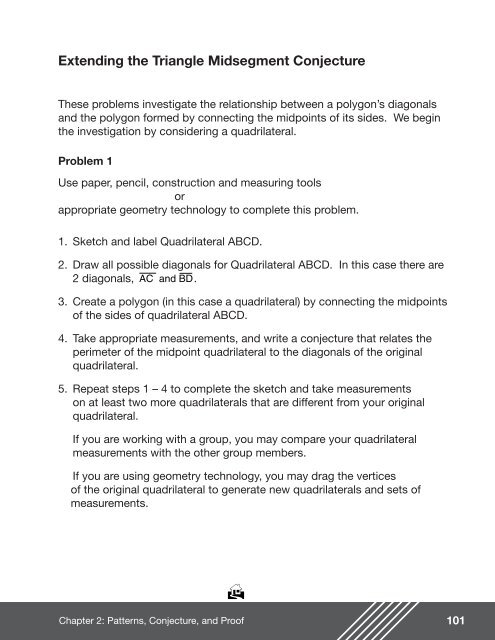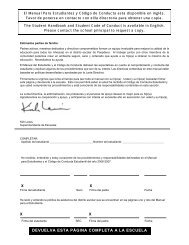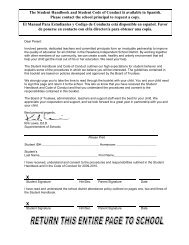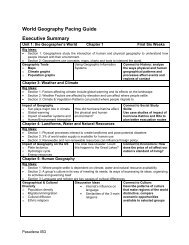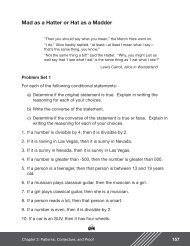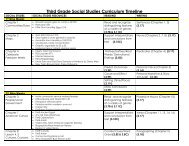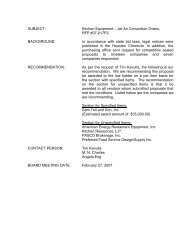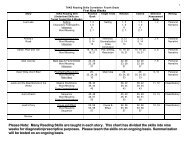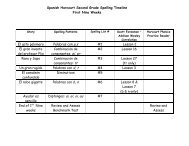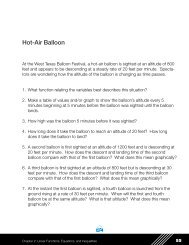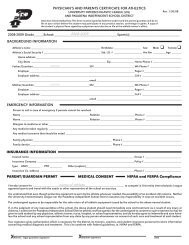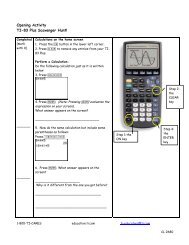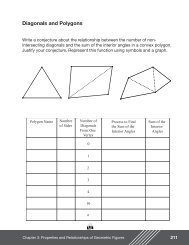Extending the Triangle Midsegment Conjecture
Extending the Triangle Midsegment Conjecture
Extending the Triangle Midsegment Conjecture
You also want an ePaper? Increase the reach of your titles
YUMPU automatically turns print PDFs into web optimized ePapers that Google loves.
<strong>Extending</strong> <strong>the</strong> <strong>Triangle</strong> <strong>Midsegment</strong> <strong>Conjecture</strong><br />
These problems investigate <strong>the</strong> relationship between a polygon’s diagonals<br />
and <strong>the</strong> polygon formed by connecting <strong>the</strong> midpoints of its sides. We begin<br />
<strong>the</strong> investigation by considering a quadrilateral.<br />
Problem 1<br />
Use paper, pencil, construction and measuring tools<br />
or<br />
appropriate geometry technology to complete this problem.<br />
1. Sketch and label Quadrilateral ABCD.<br />
2. Draw all possible diagonals for Quadrilateral ABCD. In this case <strong>the</strong>re are<br />
2 diagonals, AC and BD.<br />
3. Create a polygon (in this case a quadrilateral) by connecting <strong>the</strong> midpoints<br />
of <strong>the</strong> sides of quadrilateral ABCD.<br />
4. Take appropriate measurements, and write a conjecture that relates <strong>the</strong><br />
perimeter of <strong>the</strong> midpoint quadrilateral to <strong>the</strong> diagonals of <strong>the</strong> original<br />
quadrilateral.<br />
5. Repeat steps 1 – 4 to complete <strong>the</strong> sketch and take measurements<br />
on at least two more quadrilaterals that are different from your original<br />
quadrilateral.<br />
If you are working with a group, you may compare your quadrilateral<br />
measurements with <strong>the</strong> o<strong>the</strong>r group members.<br />
If you are using geometry technology, you may drag <strong>the</strong> vertices<br />
of <strong>the</strong> original quadrilateral to generate new quadrilaterals and sets of<br />
measurements.<br />
H<br />
Chapter 2: Patterns, <strong>Conjecture</strong>, and Proof 101
Problem 2<br />
In <strong>the</strong> Assessment, <strong>Conjecture</strong> as Proof and Proof as Explanation, you<br />
discovered and proved <strong>the</strong> <strong>Triangle</strong> <strong>Midsegment</strong> <strong>Conjecture</strong>:<br />
The midsegment of a triangle is parallel to one side of <strong>the</strong> triangle and<br />
measures half <strong>the</strong> length of that side.<br />
Since you have proved this conjecture, you can use it to help prove and<br />
explain why o<strong>the</strong>r conjectures may or may not be true.<br />
Use <strong>the</strong> <strong>Triangle</strong> <strong>Midsegment</strong> <strong>Conjecture</strong> to write an explanation of why your<br />
quadrilateral conjecture is true. Provide a diagram with your explanation.<br />
Problem 3<br />
Do you think your conjecture will be true for o<strong>the</strong>r polygons besides<br />
quadrilaterals? Why or why not?<br />
Sketch, measure, and investigate <strong>the</strong> relationship between a polygon’s<br />
diagonals and <strong>the</strong> polygon formed by connecting <strong>the</strong> midpoints of its sides.<br />
Start with a pentagon, <strong>the</strong>n a hexagon, etc.<br />
Problem 4<br />
Modify your original conjecture (or write new conjectures) to take into account<br />
o<strong>the</strong>r polygons besides quadrilaterals.<br />
H<br />
102<br />
Chapter 2: Patterns, <strong>Conjecture</strong>, and Proof
H<br />
Chapter 2: Patterns, <strong>Conjecture</strong>, and Proof 103
Teacher Notes<br />
Materials:<br />
Paper and graph paper<br />
One pencil, ruler, and protractor<br />
per student, and/or<br />
Appropriate geometry technology<br />
Connections to Geometry<br />
TEKS:<br />
(b.3) Geometric structure. The<br />
student understands <strong>the</strong><br />
importance of logical reasoning,<br />
justification, and proof in<br />
ma<strong>the</strong>matics.<br />
The student:<br />
(B) constructs and justifies<br />
statements about geometric<br />
figures and <strong>the</strong>ir properties;<br />
(C) demonstrates what it means<br />
to prove ma<strong>the</strong>matically that<br />
statements are true;<br />
(D) uses inductive reasoning to<br />
formulate a conjecture; and<br />
(E) uses deductive reasoning to<br />
prove a statement.<br />
(d.2) Dimensionality and <strong>the</strong><br />
geometry of location. The<br />
student understands that<br />
coordinate systems provide<br />
convenient and efficient ways<br />
of representing geometric figures<br />
and uses <strong>the</strong>m accordingly.<br />
The student:<br />
(C) develops and uses formulas<br />
including distance and midpoint.<br />
(f) Similarity and <strong>the</strong> geometry<br />
of shape. The student applies<br />
<strong>the</strong> concept of similarity to justify<br />
properties of figures and solve<br />
problems.<br />
The problem, <strong>Conjecture</strong> as Discovery and Proof as<br />
Explanation, asks <strong>the</strong> students to investigate and <strong>the</strong>n prove<br />
important characteristics about a triangle’s midsegment.<br />
This problem investigates <strong>the</strong> midsegment for o<strong>the</strong>r<br />
polygons. The next problem, Why Doesn’t My <strong>Conjecture</strong><br />
Always Work?, asks students to explain <strong>the</strong> results of <strong>the</strong>ir<br />
investigations for <strong>the</strong> different polygons.<br />
Scaffolding Questions:<br />
Problem 1<br />
• If students need additional structure during <strong>the</strong><br />
investigation, tell <strong>the</strong>m to restrict <strong>the</strong>ir measurements to<br />
<strong>the</strong> lengths of segments and to ignore angle measures.<br />
Problem 2<br />
• This explanation does not need to be a formal, 2-column<br />
proof. Encourage students to examine a diagram of <strong>the</strong><br />
triangle midsegment <strong>the</strong>orem and to see how this<br />
diagram applies to <strong>the</strong>ir quadrilateral diagram.<br />
Problem 3<br />
• Many students will assume that since o<strong>the</strong>r polygons<br />
have diagonals, <strong>the</strong> conjecture should “work <strong>the</strong> same<br />
way” no matter how many sides <strong>the</strong> polygon has. These<br />
investigations are a good way to get students to “listen<br />
to <strong>the</strong> math,” and to see how <strong>the</strong> geometry changes as<br />
<strong>the</strong> number of sides of <strong>the</strong> polygon increase.<br />
Problem 4<br />
• Students should see that <strong>the</strong> initial conjecture doesn’t<br />
hold for pentagons; moreover, <strong>the</strong> conjecture for<br />
pentagons doesn’t hold for hexagons. Encourage<br />
students to write separate conjectures for quadrilaterals,<br />
pentagons, and polygons with more than 5 sides.<br />
H<br />
104<br />
Chapter 2: Patterns, <strong>Conjecture</strong>, and Proof
Sample Solution:<br />
Problem 1<br />
Perimeter p1 = 21.86 cm<br />
n = 9.26 cm<br />
o = 12.59 cm<br />
n+o = 21.86 cm<br />
The student:<br />
(1) uses similarity properties and<br />
transformations to explore and<br />
justify conjectures about<br />
geometric figures;<br />
A<br />
H<br />
<strong>Conjecture</strong>: The perimeter of <strong>the</strong> midpoint quadrilateral is<br />
equal to <strong>the</strong> sum of <strong>the</strong> lengths of <strong>the</strong><br />
diagonals.<br />
Problem 2<br />
E<br />
By <strong>the</strong> <strong>Triangle</strong> <strong>Midsegment</strong> <strong>Conjecture</strong>:<br />
1<br />
1<br />
GF = BD HE = BD HG = 1 AC<br />
2<br />
2<br />
2<br />
B<br />
EF =<br />
1<br />
AC,<br />
2<br />
so<br />
GF + HE + HG + EF =<br />
1 1 1 1<br />
BD + BD + AC +<br />
2 2 2 2<br />
AC<br />
GF + HE + HG + EF = BD + AC.<br />
D<br />
G<br />
F<br />
C<br />
(2) uses ratios to solve problems<br />
involving similar figures.<br />
Texas Assessment of<br />
Knowledge and Skills:<br />
Objective 7: The student will<br />
demonstrate an understanding of<br />
two- and three-dimensional<br />
representations of geometric<br />
relationships and shapes.<br />
Objective 8: The student will<br />
demonstrate an understanding of<br />
<strong>the</strong> concepts and uses of<br />
measurement and similarity.<br />
Objective 10: The student will<br />
demonstrate an understanding of<br />
<strong>the</strong> ma<strong>the</strong>matical processes and<br />
tools used in problem solving.<br />
Connection to High School<br />
Geometry: Supporting TEKS and<br />
TAKS Institute:<br />
I. Structure: Geometric<br />
Structure: Midpoint<br />
Quadrilateral<br />
Therefore <strong>the</strong> perimeter of <strong>the</strong> midpoint quadrilateral is equal<br />
to <strong>the</strong> sum of <strong>the</strong> lengths of <strong>the</strong> diagonals.<br />
H<br />
Chapter 2: Patterns, <strong>Conjecture</strong>, and Proof 105
Problem 3<br />
For a pentagon:<br />
Perimeter p1 = 20.24 cm<br />
EB+BD+DA+AC+CE = 40.47 cm<br />
K<br />
A<br />
( EB+BD+DA+AC+CE)<br />
( Perimeter p1)<br />
J<br />
= 2.00<br />
E<br />
B<br />
G<br />
I<br />
D<br />
H<br />
C<br />
For a hexagon, and for polygons with more than six sides:<br />
B<br />
C<br />
A<br />
D<br />
F<br />
Perimeter p1 = 34.23 cm<br />
E<br />
AC+AD+AE+BD+BE+BF+CF+CE+DF=107.80 cm<br />
There is no relationship; <strong>the</strong> ratio between perimeter of midpoint polygon and sum of<br />
diagonals changes with different hexagons.<br />
H<br />
106<br />
Chapter 2: Patterns, <strong>Conjecture</strong>, and Proof
Problem 4<br />
<strong>Conjecture</strong>: The perimeter of <strong>the</strong> midpoint quadrilateral is equal to <strong>the</strong> sum of <strong>the</strong> lengths<br />
of <strong>the</strong> diagonals.<br />
<strong>Conjecture</strong>: The perimeter of <strong>the</strong> midpoint pentagon is one-half <strong>the</strong> sum of <strong>the</strong> lengths<br />
of <strong>the</strong> diagonals.<br />
<strong>Conjecture</strong>: There does not appear to be any relationship between <strong>the</strong> perimeter of <strong>the</strong><br />
midpoint polygon and <strong>the</strong> sums of <strong>the</strong> lengths of <strong>the</strong> diagonals for polygons<br />
with more than 5 sides.<br />
Extension Questions:<br />
• Use <strong>the</strong> <strong>Triangle</strong> <strong>Midsegment</strong> <strong>Conjecture</strong> to explain why your conjecture for pentagons<br />
must be true.<br />
Perimeter p1 = 20.24 cm<br />
EB+BD+DA+AC+CE = 40.47 cm<br />
K<br />
A<br />
( EB+BD+DA+AC+CE)<br />
( Perimeter p1)<br />
J<br />
= 2.00<br />
E<br />
B<br />
G<br />
I<br />
D<br />
H<br />
C<br />
By <strong>the</strong> <strong>Triangle</strong> <strong>Midsegment</strong> <strong>Conjecture</strong>:<br />
1<br />
1<br />
1<br />
1<br />
1<br />
KJ = EB JI = AC IH = BD GH = EC GK = AD,<br />
2<br />
2<br />
2<br />
2<br />
2<br />
so<br />
1<br />
KJ + JI + IH + GH + GK = EB + AC + BD + EC + AD.<br />
2<br />
Therefore <strong>the</strong> perimeter of <strong>the</strong> midpoint pentagon is one-half <strong>the</strong> sum of <strong>the</strong> lengths of<br />
<strong>the</strong> diagonals.<br />
• Use Coordinate Geometry to prove <strong>the</strong> quadrilateral conjecture.<br />
H<br />
Chapter 2: Patterns, <strong>Conjecture</strong>, and Proof 107
B(2r, 2s)<br />
E(r+t, s+p)<br />
C(2t, 2p)<br />
H(r, s)<br />
F(t+q, p)<br />
A(0,0) G(q, 0) D(2q, 0)<br />
2 2 2 2<br />
HE = ( r + t − r ) + ( s + p − s)<br />
= t + p<br />
2 2 2 2<br />
FG = ( t + q − q)<br />
+ p = t + p<br />
EF =<br />
2 2 2 2<br />
( r + t − t − q) + ( s + p − p) = ( r − q)<br />
+ s<br />
2 2<br />
GH = ( r − q)<br />
+ s<br />
BD = ( 2( r − q)) + ( 2s) = 4( r − q) + 4s = 4(( r − q) + s )<br />
= 2 (( r − q) + s )<br />
2 2 2 2 2 2<br />
2 2<br />
2 2 2 2 2 2 2 2<br />
AC = ( 2t ) + ( 2 p) = 4t + 4p = 4( t + p ) = 2 ( t + p )<br />
2 2 2 2<br />
HE + GF + EF + GH = 2 t + p + 2 ( r − q)<br />
+ s<br />
BD + AC =<br />
2 2 2 2<br />
2 t + p + 2 ( r − q)<br />
+ s<br />
Therefore, <strong>the</strong> perimeter of <strong>the</strong> midpoint quadrilateral is equal to <strong>the</strong> sum of <strong>the</strong> lengths<br />
of <strong>the</strong> diagonals.<br />
H<br />
108<br />
Chapter 2: Patterns, <strong>Conjecture</strong>, and Proof


